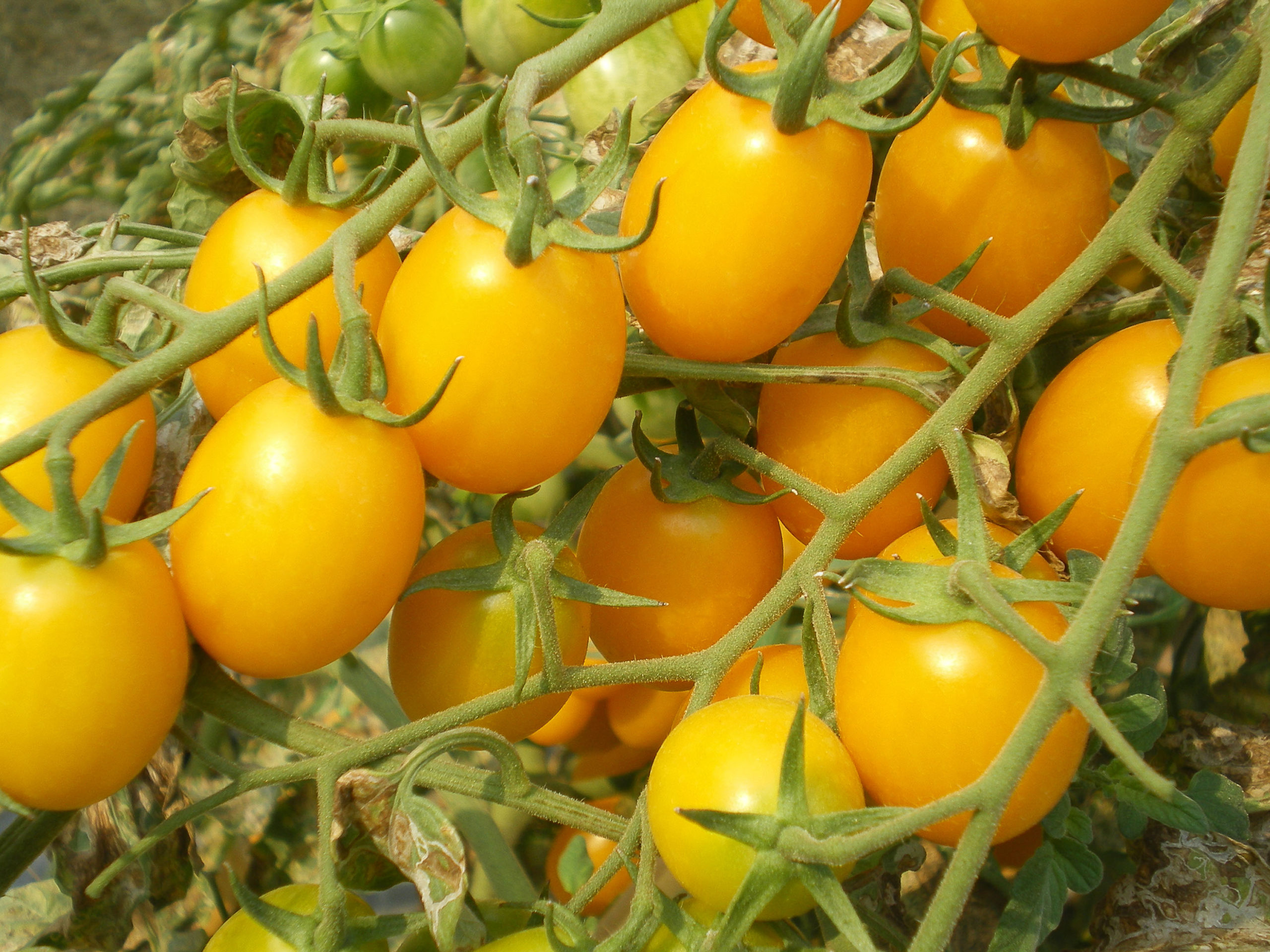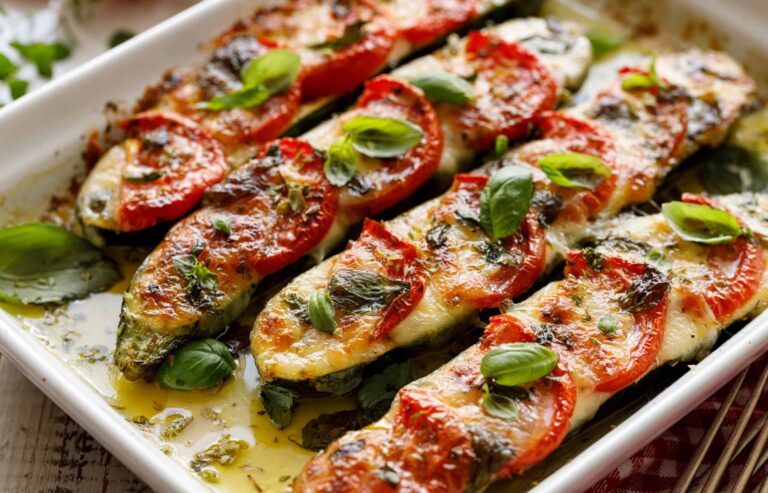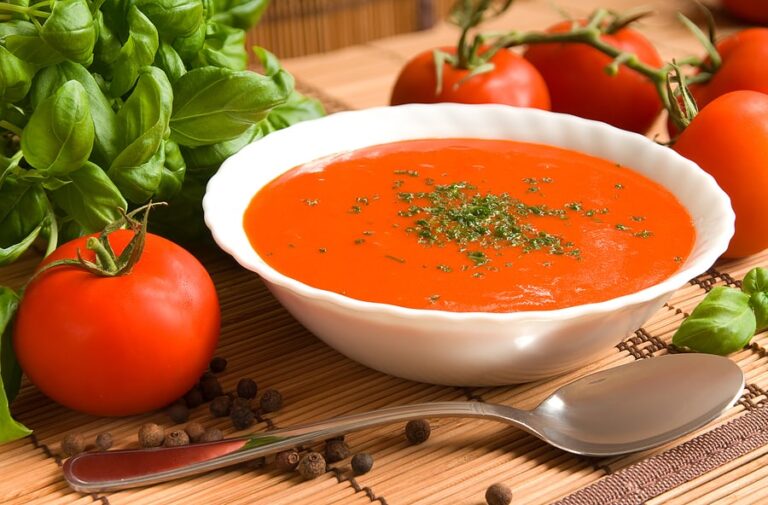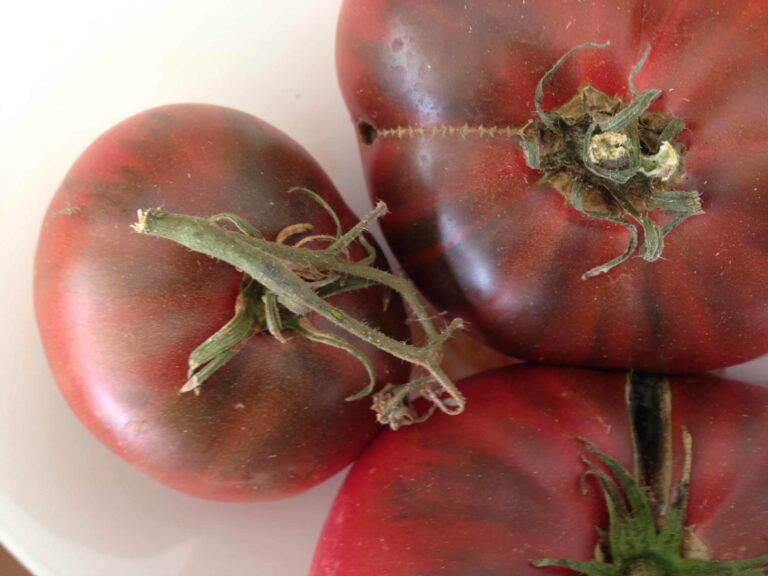Growing Early-Season Tomatoes for Great Taste
Early-season tomatoes ripen fruit 55 to 70 days after being transplanted to the garden as 6-week-old plants.
Because great tomato flavor comes with just the right combination of sugars and acids that are the product of sunlight and photosynthesis, early-season tomatoes are often dismissed as less tasty than mid- and late-season tomatoes (which require 80 to more than 100 days to ripen) because they spend fewer days in the sun.

But many “early” tomatoes—which are often smaller and less leafy than later-season tomatoes–can flower and set fruit in cool, early-season conditions. Given optimal conditions, early-season tomatoes can produce fruit equally flavorful to the best late-season varieties.
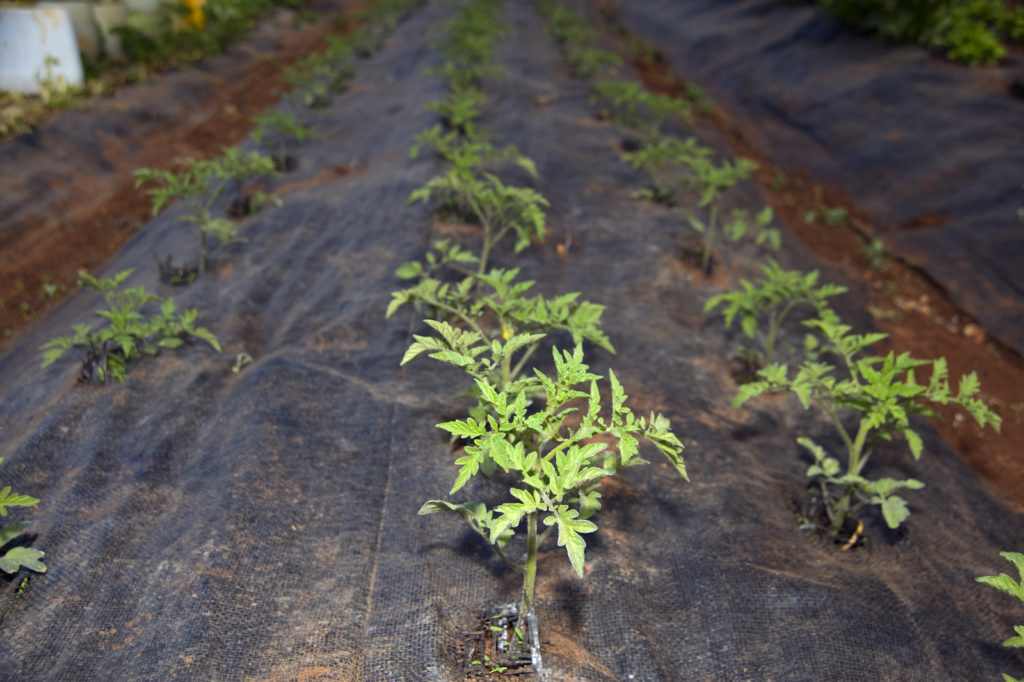
How to Grow Tomatoes Early in the Season
- Start seed indoors. Start seeds indoors 5 to 6 weeks before the last expected frost.
- Pot up. Two to three weeks after germination, pot up seedlings to quart or gallon containers; larger containers will allow roots that support fruiting to more fully develop before plants are set out in the garden.
- Long light. Place seedlings under a bright light for 16 to 18 hours each day; set young plants under tube fluorescent bulbs so that they do not grow weak or spindly.
- Strong stems. Brush the top of seedlings with the edge of your hands for a few minutes each day; this will help stems grow strong.
- Planting site. Set plants in the garden where they will receive at least 8 hours of sun each day. Sunlight is essential for photosynthesis and the production of sugars and acids.
- Preheat soil. Before setting out plants, preheat the soil by placing black plastic sheeting across the planting bed and let the soil warm for 7 to 10 days. Slit a hole in the plastic for each plant when it is time to transplant.
- Set deep. Transplant each seedling so that the top leaves are just above the soil surface; extra roots along the buried stem.
- Feed early. At the bottom of each planting hole, throw in a handful of aged compost or aged steer manure and a half handful of bone meal or organic tomato fertilizer. These will be high in phosphorus and potassium—nutrients essential for root and fruit development.
- Spacing. Make sure plants are well spaced so that they get plenty of air and light throughout the day, essential for early plant development and later fruit development.
- Support. Set a cage, trellis, or stake in place when you transplant. Avoid staking later after roots have developed and can be damaged.
- Prune. Remove suckers and some flowers from large blossom clusters; this will allow the plant to put its energy into larger and earlier tomatoes.
- Water. Keep the soil evenly moist—not dry, not wet. Even soil moisture allows for uninterrupted flower and fruit development.
- Harvest. Withhold water in the last week to 10 days before harvest; this will concentrate sugars and flavor. Pick on or about the suggested days to maturity–the peak of flavor.
Early, Mid, and Late-Season Tomatoes Growing Strategy
If your garden is large enough, plant tomatoes that are ready early in the season (those listed here), tomatoes that are ready mid-season ( summer and late summer), and tomatoes that are ready at the end of the season (late summer and early autumn). Plant these tomatoes a few weeks after the last frost in spring and you will have a succession of great-tasting tomatoes, a staggered harvest.
More how-to-grow tomatoes articles
How to Plant, Grow, and Harvest Tomatoes
Garden Planning Books at Amazon:
- Tomato Grower’s Answer Book
- Vegetable Garden Almanac & Planner
- Kitchen Garden Grower’s Guide Vegetable Encyclopedia
- Vegetable Garden Grower’s Guide
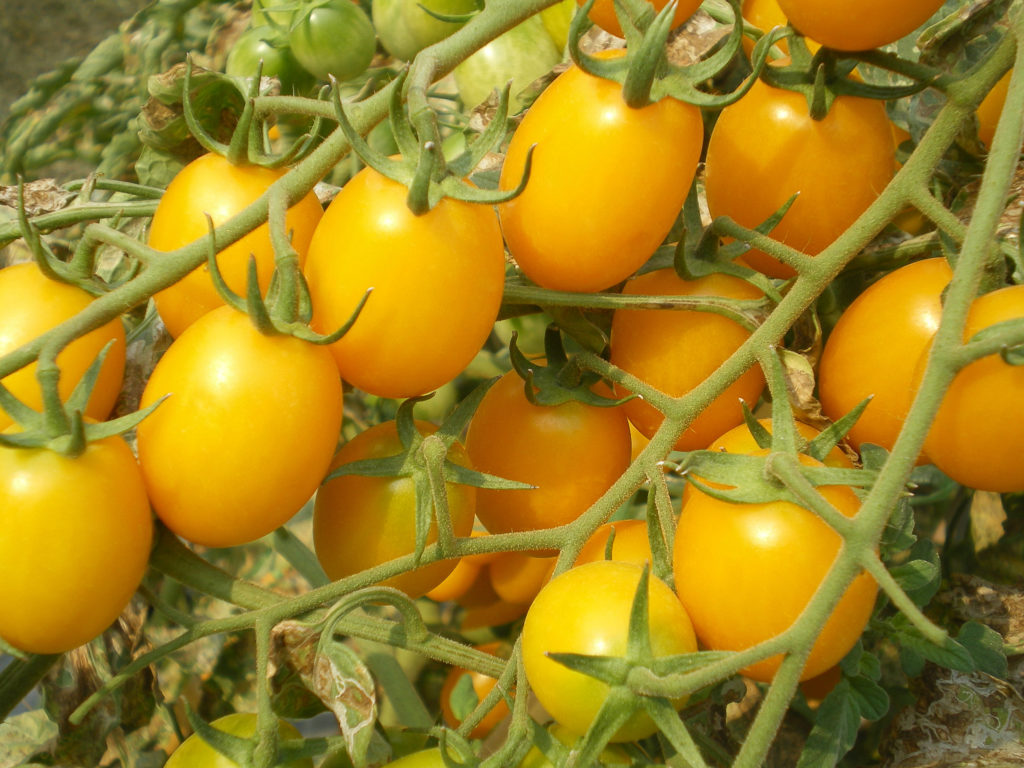
Best Flavored Tomatoes for Early-Season Growing
Some early-season tomato varieties have been hybridized for flavor; many open-pollinated varieties have been selected by gardeners for their early-season flavor. Here are flavorful and easy-to-find early-season tomatoes:
- ‘Anna Russian’ (open-pollinated). Slicing tomato. Pink-red, heart-shaped, 10-ounce fruits; juicy, excellent sweet flavor. 70 days. Indeterminate.
- ‘Beefmaster’ (hybrid). Slicing tomato. Red-skinned, deep oblate shape; flavorful. 60 days. Indeterminate. VFN.
- ‘Bush Celebrity’ (hybrid). Slicing tomato. Red-skinned with green shoulders to 9 ounces; excellent flavor. 67 days. Determinate.
- ‘Cherry Grande’ (hybrid). Salad tomato. Red-skinned, uniform, round; good flavor. 65 days. Determinate. Disease resistant.
- ‘Cherry Pink’ (hybrid). Slicing tomato. Pink-skinned, medium size; very sweet. 68 days. Determinate.
- ‘Clear Pink Early’ (open-pollinated). Slicing tomato. Red-skinned, round, clear pink fruit; sweet and tangy. 58 days. Determinate. Russian heirloom.
- ‘Cupid’ (hybrid). Salad tomato. Red, small, oval fruit in clusters of 16 fruits; sweet taste. 62 days. Indeterminate. F.
- ‘Earliana’ (open-pollinated). Slicing tomato. Bright scarlet skin; green shoulders, medium sizes to 5 ounces; solid flesh, good flavor. 58 days. Indeterminate.
- ‘Early Cascade’ (hybrid). Slicing tomato. Red-skinned, medium-sized, globe to 8 ounces; excellent flavor. 55 days. Indeterminate. VFN.
- ‘Early Girl Bush’ (hybrid). Slicing tomato. Red-skinned to 6 ounces; flavorful. 52 days. Determinate. Disease resistant. Performs in nearly all climates.
- Early Girl Bush (hybrid). Slicing tomatoes.
- ‘Early Pick’ (hybrid). Slicing tomato. Scarlet-skinned, medium size to 8 ounces or more; full-flavored. 55 days. Determinate.
- ‘Early Wonder’ (open-pollinated). Slicing tomato. Dark-pink skinned to 6 ounces; full-flavored. 55 days. Determinate.
- ‘Fireworks’ (open-pollinated). Slicing tomato. Bright red, round with a pointed tip to 8 ounces; excellent flavor. 60 days. Determinate.
- ‘First Lady’ (hybrid). Slicing tomato. Red-skinned to 5 ounces. 66 days. Indeterminate. Disease and crack resistant.
- ‘Galina’s’ (open-pollinated). Salad tomato. Yellow cherry tomato. Excellent flavor; 54 days. Indeterminate.
- ‘Gardener’s Delight’ (open-pollinated). Salad tomato. Bright red, small, round to 1½ inches in diameter; sweet flavor. 68 days. Indeterminate. Produces until frost.
- ‘German Lunch Box’ (hybrid). Salad tomato. Red-skinned, egg-shaped, thin-skinned; sweet. 62 days. Determinate.
- ‘Glacier’ (open-pollinated). Slicing tomato. Red, small, round to 2½ inches in diameter to 3 ounces; sweet. 54 days. Determinate, very productive. Heirloom from Sweden.
- ‘Gold Nugget’ (open-pollinated). Cherry tomato. Gold-skinned, round to oval fruit; balanced flavor. 56 days. Determinate.
- ‘Golden Cherry’ (hybrid). Salad tomato. Golden, thin-skinned; very sweet. 65 days. Indeterminate. Resists cracking.
- ‘Golden Delight’ (open-pollinated). Slicing tomato. Yellow-orange skinned; globe-shaped to 4 ounces; rich flavor. 60 days. Determinate, compact. Developed at South Dakota State University.
- ‘Golden Honey Bunch’ (hybrid). Salad tomato. Golden yellow, grape type in clusters of 11 fruits; sweet flavor. 60 days. Determinate. VFFT.
- ‘Golden Sweet’ (hybrid). Salad tomato. Deep yellow, bite-size; mild, sweet flavor. 60 days. Indeterminate. Resists cracking.
- ‘Gregori’s Altai’ (open-pollinated). Slicing tomato. Pink-red beefsteak to 12 ounces; sweet-acid flavor. 67 days. Indeterminate. Long season. From Siberia.
- ‘Harbinger‘(hybrid). Slicing tomato. Red-skinned, medium-small, good flavor. Prone to cracking. 60 days. Indeterminate. Traditional English tomato from 1910.
- ‘Imur Prior Beta’ (hybrid). Slicing tomato. Red-skinned, small to 4 ounces, firm, flavorful. 60 days. Indeterminate. Developed by Washington State University for short seasons.
- ‘Jetsetter’ (hybrid). Slicing tomato. Red-skinned to 8 ounces; rich flavor. 64 days. Indeterminate. VFFNTA. Performs well in the South.
- ‘Juliet’ (hybrid). Salad tomato. Red-skinned, meaty to 2 ounces, in clusters of 10 to 12; flavorful. 60 days. Determinate. Resists cracking.
- ‘Kotlas’ (open-pollinated). Small cherry tomato. Red skin, 2-inch fruits; sweet flavor. 60 days. Determinate.
- ‘Legend’ (open-pollinated). Slicing tomato. Red-skinned, round fruit to 8 ounces; good flavor blending sugars and acids. 68 days. Indeterminate. Disease resistant.
- ‘Miracle Sweet’ (hybrid).Slicing tomato. Red-skinned, uniform fruit to 5 ounces; sweet flavor. 67 days. Indeterminate. VFFNT.
- ‘Moskvich’ (open-pollinated). Slicing tomato. Deep red skin, globe-shaped to 6 ounces. 60 days. Indeterminate. From Eastern Siberia.
- ‘Mountain Spring’ (hybrid). Slicing tomato. Dark red, globe-shaped to 9 ounces. 68 days. Determinate, compact. VFF.
- ‘Napoli’ (open-pollinated). Paste tomato. Red, pear- to plum-shaped fruit; concentrated flavor. 63 days. Semi-determinate. VF.
- ‘New Girl’ (hybrid). Slicing tomato. Red skinned medium size to 6 ounces; rich, full flavor. 62 days. Indeterminate.
- ‘New Yorker’ (open-pollinated). Slicing size. Scarlet fruit, medium size to 6 ounces, meaty, fine flavor. 63 days. Determinate, compact. V. Good in cool, northern, short-season regions.
- ‘Oregon Spring’ (hybrid). Slicing tomato. Medium size to 8 ounces, excellent flavor. 58 days. Determinate. VF. Adapted to cool summer nights. Developed at Oregon State University.
- ‘Peron’, ‘Peron Sprayless’ (open-pollinated). Slicing tomato. Bright scarlet fruit, medium-large to 8 ounces; solid flesh, flavorful. 68 days. Indeterminate. Disease resistant. From South America.
- ‘Pixie’, ‘Burpee’s Pixie’. Salad tomato. Scarlet fruit, globe-shaped; meaty, juicy, very flavorful. 55 days. Determinate, compact. Good for northern regions. Grows well in a container.
- ‘Prairie Fire’ (open-pollinated). Slicing tomato. Red-skinned to 5 ounces; tangy full flavor. 55 days. Determinate. Sub Arctic-beefsteak cross.
- ‘Red Alert’ (hybrid). Salad tomato. Red-skinned; flavorful. 55 days. Determinate.
- ‘Santiam’ (open-pollinated). Slicing tomato. Medium size to 5 ounces; slightly acidic, sweet, and juicy. 58 days. Determinate FV.
- ‘Sasha’s Altai’ (open-pollinated). Salad tomato. Bright red, slightly flattened fruits, 5 to 8 ounces. Complex flavor. 57 days. Determinate.
- ‘Scotia’ (open-pollinated). Slicing tomato. Deep-red fruit, slightly green shoulders; medium size to 4 ounces; good flavor. 60 days. Determinate. Sets well in cool weather.
- ‘Siletz’ (open-pollinated). Slicing tomato. Red-skinned fruits to 4 inches; excellent flavor. Cold tolerant. 57 days. Determinate.
- ‘Silvery Fir Tree’ (open-pollinated). Salad tomato. Red-skinned with a silver sheen to 6 ounces; flavorful. 58 days. Determinate. Russian heirloom.
- ‘Small Fry’ (hybrid). Salad tomato. Red, small, round, 1-inch in diameter, very flavorful. 65 days. Determinate, compact. VF. All-America Selection. Grow in a container.
- ‘Sophie’s Choice’ (open-pollinated). Slicing tomato. Red-orange skin with red flesh, heavy fruiting. Best in cool to cold regions. 55 days. Determinate.
- ‘Spitfire’ (hybrid). Slicing tomato. Dark red, globe-shaped; excellent taste. 68 days. Determinate. VFF.
- ‘Stupice’ (open-pollinated). Slicing tomato. Red-skinned, small to medium-sized to 4 ounces; sweet, juicy. 50 days. Dwarf determinate, compact. For short-season regions. From Czechoslovakia.
- ‘Sub Arctic Plenty’ (open-pollinated). Slicing tomato. Small, round to 2 ounces; good flavor. 50 days. Determinate, compact. Sets fruit in cold weather.
- ‘Sugar Lump’, ‘Jung’s Sugar Lump’ (open-pollinated). Salad tomato. Deep red, round to 2 inches in diameter; very sweet. Indeterminate. Produces until frost.
- ‘Sugary’ (hybrid). Grape tomato. Bright red grape-shape to ½ ounce in clusters to 20 fruits; very flavorful. 65 days. Indeterminate. Resists cracking.
- ‘Sun Gold’ (hybrid). Cherry tomato. Bright orange-skinned; sweet flavor. 57 days. Indeterminate. TMVF.
- ‘Sunshine’ (hybrid). Slicing tomato. Red-skinned, improved Sunstart; flavorful. 64 days. Determinate. VFF.
- ‘Sunstart’ (hybrid). Slicing tomato. Red-skinned to 7 ounces; firm and tasty. 65 days. Determinate.
- ‘Sweet Million’ (hybrid). Salad tomato. Deep red, small round; sweet flavor. 60 days. Indeterminate
- ‘Sweet Orange’ (hybrid).Salad tomato. Orange-skinned, firm round, cherry fruit; very sweet. 60 days. Determinate. TMVF.
- ‘Sweet 100’ (hybrid). Salad tomato. Red, small, round, extremely sweet. 65 days. Indeterminate; best staked.
- ‘Sweetie’ (open-pollinated). Salad tomato. Bright red, round to 1½ inches in diameter; very sweet, flavorful. 65 days. Indeterminate. Best staked.
- ‘Taxi’ (open-pollinated). Slicing tomato. Bright yellow, medium round; firm, meaty, sweet flavor. 64 days. Determinate, compact.
- ‘Thessaloniki’ (open-pollinated). Slicing tomato. Uniform, globe-shaped fruit to 2 inches in diameter; juicy, mild flavor. 68 days. Indeterminate. Disease resistant.
- ‘Tigerella’, ‘Mr. Stripey’ (open-pollinated). Slicing tomato. Reddish-orange, striped with golden yellow to 2 inches in diameter; very good flavor. 56 days. Indeterminate. Good disease resistance.
- ‘Tumbler’ (hybrid). Patio tomato. Bright red, masses to 1¼ inch fruits; sweet flavor. 48 days. Determinate.
- ‘Tumbling Tom’ Cherry tomato. Bright red, trailing produces in clusters; good flavor. 65 days. Determinate.
- ‘Ultra Sweet’ (hybrid). Slicing tomato. Bright red skin, deep globe, firm to 10 ounces; balanced sugar and acids. 62 days. Determinate. VFT. Crack-resistant.
- ‘Wayahead’ (hybrid). Slicing tomato. Red skin, smooth, slightly flattened, full flavor. 63 days. Determinate. Long season production.
- ‘Whippersnapper’ (open-pollinated). Salad tomato. Very early, dark-pink, oval, sweet, and flavorful. 52 days. Determinate, compact.
- ‘Yellow Bell’ (open-pollinated). Paste tomato. Yellow, plum shape; rich and sweet. 60 days. Indeterminate. Heirloom.
Tomato Growing Hub
Start here: The Ultimate Tomato Growing Guide: From Seed to Harvest
Growing Tips
- Getting Started with Tomatoes: A Gardener’s Guide to Success
- How to Choose a Tomato for Your Garden
- Growing Early-Season Tomatoes for Great Taste
- Heirloom and Hybrid Tomatoes
Planting Tips
- Tomato Seed Starting Tips
- Mastering Tomato Seed Starting: How to Grow Strong and Healthy Plants Indoors
- When to Plant Tomatoes: A Gardener’s Guide to Timing and Success
- Plant Tomatoes for a Thriving Crop: Sun, Soil, and Spacing
- How to Transplant Tomato Seedlings: A Gardener’s Guide
- Growing Tomatoes in Containers
Tomato Care
- Watering and Feeding Tomatoes: Expert Tips for a Healthy, Productive Crop
- Best Ways to Support Your Tomato Plants
- Pinching and Pruning Tomatoes: A Gardener’s Guide to Healthier, More Productive Plants
- How to Prune Tomatoes
- Grow Tomatoes on Stakes
- Best Companion Plants for Thriving Tomatoes: What Works & What to Avoid
Pest & Disease Control
- Tomato Growing Problems: Pests, Diseases, and Solutions
- How to Prevent Blossom Drop — Tomatoes and Peppers
- How to Identify Early Blight, Late Blight, and Leaf Spot on Tomatoes
Harvest & Preparation
- When and How to Harvest Tomatoes for the Best Flavor
- How to Ripen Tomatoes
- Planting Tomatoes for a Long Harvest
- Planting Tomatoes for a Fall Harvest: How to Grow Fresh Tomatoes Before Frost
- Tomato Flavor Explained
- Nine Ways to Cook and Serve Tomatoes
Garden Planning Books at Amazon:

